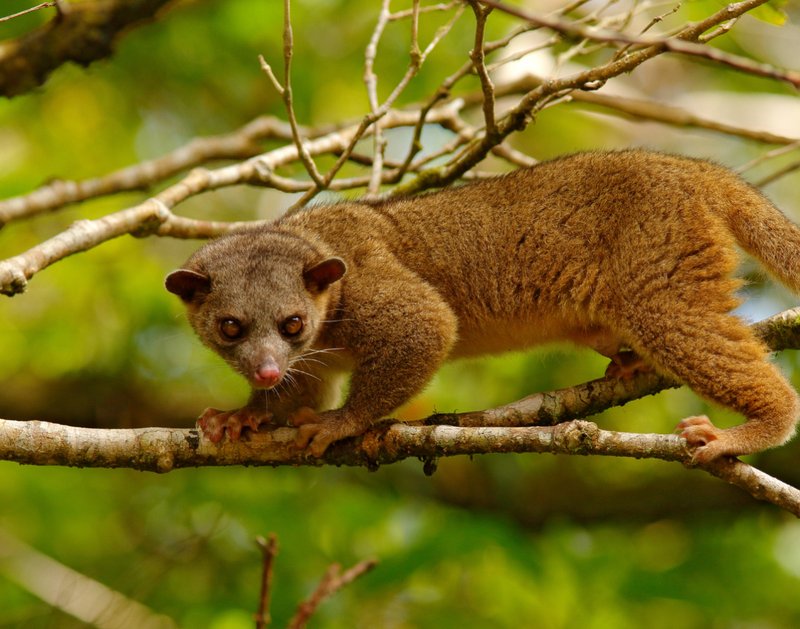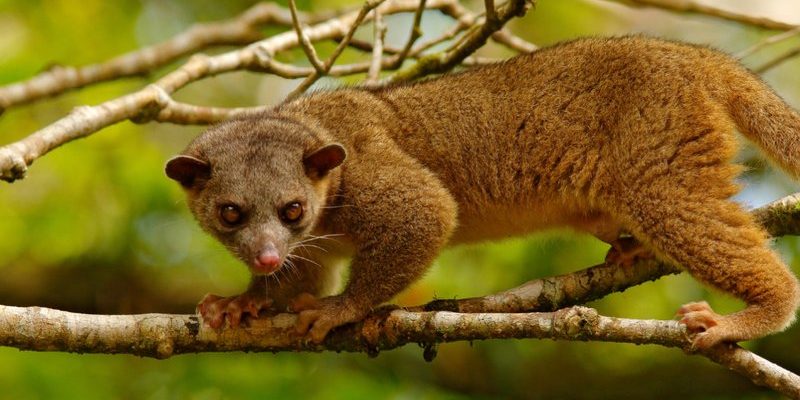
In this article, let’s dive into the fascinating world of kinkajous and explore the best ways to interact with these lovable creatures safely. It’s like preparing for a friendly chat with an intriguing stranger. Whether you’re a wildlife enthusiast or just someone who loves nature, understanding how to approach a kinkajou can make your experience memorable and safe.
So, let’s break it down step by step like we’re sipping coffee together and chatting about your upcoming adventure!
Understanding Kinkajous: Nature’s Playful Little Mammals
Kinkajous (Potos flavus) are small, nocturnal mammals native to Central and South America. With their soft, golden-brown fur, large eyes, and charmingly long tails, they look like they’ve stepped right out of a children’s book. On average, they weigh about 5 to 10 pounds and measure around 16 to 24 inches in length, with their tails adding another 16 to 24 inches. Here’s the thing: they’re part of the Procyonidae family, which means they’re cousins to raccoons!
These playful animals are usually found in treetops, where they spend their nights looking for fruits, flowers, and nectar. Think of them as the party-goers of the jungle, swinging from branch to branch, often in groups. If you spot a kinkajou during your hike, take a moment to appreciate its playful antics. But keep in mind that while they seem friendly, they are wild animals and should be treated with respect.
What to Do When You Spot a Kinkajou
So, your heart races as you spot a kinkajou. What should you do? First, take a deep breath. It’s like seeing a rare Pokémon in the wild! Here’s a simple guide to handling the situation.
1. Stay Calm: Remember, kinkajous are often just as curious about you as you are about them. Avoid sudden movements or loud noises, as this might scare them away.
2. Observe Quietly: Find a safe distance where you can still see the kinkajou. Use this moment to take photos if you want, but remember to switch off your flash—bright lights can be unsettling for them.
3. Avoid Feeding: It might be tempting to offer snacks, but feeding wild animals can cause them to become dependent on humans. Plus, a kinkajou’s diet is specialized for their ecological role, so stick to observing instead of interacting.
By following these simple steps, you can enjoy a fantastic wildlife encounter without overstimulating the kinkajou.
Potential Risks of Getting Too Close
While kinkajous are usually friendly, they are still wild animals—and that brings certain risks. You might be wondering, “What could possibly go wrong?” Let’s break it down.
– Bites and Scratches: If a kinkajou feels threatened, it may defend itself. Their sharp teeth can inflict serious bites, so getting too close isn’t a good idea.
– Zoonotic Diseases: Wild animals can carry diseases that can spread to humans, like leptospirosis. So, avoiding contact is wise for both your health and the kinkajou’s well-being.
– Disturbing Their Habitat: Kinkajous play a crucial role in their ecosystem. Disturbing their living space can lead to stress and disrupt their foraging patterns.
Think of kinkajous as charming yet spunky guests at a party. It’s best to keep your distance and let them enjoy themselves!
How to Capture the Moment Safely
If you’re determined to document this magical moment, here’s how to do it safely:
1. Use Zoom: Instead of getting up close, use the zoom feature on your camera or phone. You’ll get a clear shot while keeping your distance.
2. Capture the Environment: Kinkajous are more than just their cute faces. Try photographing them in their natural habitat, surrounded by trees and other wildlife. This adds context to your images.
3. Be Patient: Wildlife photography can take time! Patience is key here. Wait for the right moment, and don’t rush it.
By approaching your photography this way, you’ll get memorable shots without disturbing these fascinating creatures.
Understanding Kinkajou Behavior
Kinkajous are unique not just in appearance but also in behavior. You might be curious about how they interact within their communities. Here’s a look into their social life:
– Social Creatures: Kinkajous are known to be quite social. They often live in small family groups, typically consisting of a mother and her offspring. They communicate through a series of whistles and growls, which might sound amusing if you hear them.
– Nocturnal Lifestyle: Unlike many animals, kinkajous are nighttime adventurers. They sleep during the day, curling up in tree hollows, and begin their activities as dusk falls. If you spot them at night, you’ll witness their playful and energetic side full of acrobatics.
– Territorial Marking: Male kinkajous tend to be territorial and may engage in scent-marking to establish boundaries. So if you encounter a male, keep your distance to avoid any confrontations.
Understanding their behavior helps you appreciate these animals even more and guides how to interact with them appropriately.
When to Seek Help
Sometimes, you might stumble upon a kinkajou that seems unwell or is in distress. This can be alarming, but knowing what to do can make a difference.
1. Look for Signs: If the kinkajou appears lethargic, has visible injuries, or is acting strangely, it may need help. Look for signs of distress, like excessive vocalization or inability to climb.
2. Contact Wildlife Authorities: If you suspect that a kinkajou is in trouble, reach out to local wildlife authorities or rescue organizations. They can provide guidance on what steps to take next.
3. Do Not Attempt to Capture: While it might be tempting to help, never try to catch or restrain a kinkajou on your own. This could lead to more harm for both you and the animal.
Being a responsible observer is an essential part of appreciating wildlife!
Final Thoughts on Kinkajou Encounters
Encountering a kinkajou in the wild can be a magical experience—a moment that connects you to nature in a unique way. Remember, they’re playful and curious but also wild animals deserving of respect.
By observing safely, avoiding disturbances, and appreciating their natural behaviors, you enhance not only your experience but also their well-being. So, the next time you’re out adventuring, keep your eyes peeled and your heart open. You never know when a kinkajou may decide to drop by for a visit!

